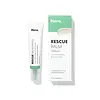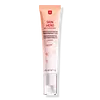Hero Cosmetics Rescue Balm Color Correcting Green Cream Versus Erborian Skin Hero Bare Skin Perfector
What's inside
What's inside
 Key Ingredients
Key Ingredients

 Benefits
Benefits

 Concerns
Concerns

 Ingredients Side-by-side
Ingredients Side-by-side

Water
Skin ConditioningDipropylene Glycol
HumectantIsononyl Isononanoate
EmollientButylene Glycol
HumectantOctyldodecanol
EmollientDiethylhexyl Carbonate
EmollientButyloctyl Salicylate
Skin ConditioningButyrospermum Parkii Butter
Skin ConditioningPolyglyceryl-3 Polyricinoleate
EmulsifyingSilica
AbrasivePanthenol
Skin ConditioningSodium Chloride
MaskingDisteardimonium Hectorite
StabilisingMica
Cosmetic ColorantHydrogenated Poly(C6-14 Olefin)
EmollientHydrogenated Polydecene
EmollientHydrogenated Polyisobutene
EmollientPolyglyceryl-4 Diisostearate/Polyhydroxystearate/Sebacate
EmulsifyingBeta-Glucan
Skin ConditioningTocopheryl Acetate
AntioxidantSpirulina Platensis Powder
Skin ProtectingTheobroma Cacao Fruit Powder
Skin ConditioningRh-Polypeptide-1
Skin ConditioningSh-Oligopeptide-1
Skin ConditioningSh-Oligopeptide-2
Skin ConditioningRh-Polypeptide-62
Skin ConditioningRh-Polypeptide-3
Skin ConditioningAllantoin
Skin ConditioningGlycerin
HumectantSynthetic Beeswax
Emulsion StabilisingPolyglyceryl-2 Triisostearate
EmulsifyingPropylene Carbonate
SolventSorbitan Isostearate
EmulsifyingAcrylates/Ammonium Methacrylate Copolymer
Xanthan Gum
EmulsifyingCaprylyl Glycol
EmollientTriethoxycaprylylsilane
Diglycerin
HumectantAluminum Hydroxide
EmollientBoron Nitride
Absorbent1,2-Hexanediol
Skin ConditioningSodium Benzoate
MaskingPotassium Sorbate
PreservativeEthylhexylglycerin
Skin ConditioningCI 77891
Cosmetic ColorantCI 77491
Cosmetic ColorantCI 77492
Cosmetic ColorantCI 77499
Cosmetic ColorantCI 77288
Cosmetic ColorantWater, Dipropylene Glycol, Isononyl Isononanoate, Butylene Glycol, Octyldodecanol, Diethylhexyl Carbonate, Butyloctyl Salicylate, Butyrospermum Parkii Butter, Polyglyceryl-3 Polyricinoleate, Silica, Panthenol, Sodium Chloride, Disteardimonium Hectorite, Mica, Hydrogenated Poly(C6-14 Olefin), Hydrogenated Polydecene, Hydrogenated Polyisobutene, Polyglyceryl-4 Diisostearate/Polyhydroxystearate/Sebacate, Beta-Glucan, Tocopheryl Acetate, Spirulina Platensis Powder, Theobroma Cacao Fruit Powder, Rh-Polypeptide-1, Sh-Oligopeptide-1, Sh-Oligopeptide-2, Rh-Polypeptide-62, Rh-Polypeptide-3, Allantoin, Glycerin, Synthetic Beeswax, Polyglyceryl-2 Triisostearate, Propylene Carbonate, Sorbitan Isostearate, Acrylates/Ammonium Methacrylate Copolymer, Xanthan Gum, Caprylyl Glycol, Triethoxycaprylylsilane, Diglycerin, Aluminum Hydroxide, Boron Nitride, 1,2-Hexanediol, Sodium Benzoate, Potassium Sorbate, Ethylhexylglycerin, CI 77891, CI 77491, CI 77492, CI 77499, CI 77288
Water
Skin ConditioningButylene Glycol
HumectantPolymethyl Methacrylate
Glycerin
HumectantSodium Acrylates Crosspolymer-2
AbsorbentBetaine
HumectantPanax Ginseng Root Extract
EmollientGlycyrrhiza Glabra Root Extract
BleachingDioscorea Villosa Root Extract
Skin ConditioningKigelia Africana Fruit Extract
Skin ConditioningZea Mays Starch
AbsorbentBacillus Ferment
Skin ConditioningSqualane
EmollientSodium Hyaluronate
HumectantAmmonium Acryloyldimethyltaurate/Vp Copolymer
Hydroxyethyl Acrylate/Sodium Acryloyldimethyl Taurate Copolymer
Emulsion StabilisingEthylhexylglycerin
Skin ConditioningMica
Cosmetic Colorant1,2-Hexanediol
Skin ConditioningSynthetic Fluorphlogopite
Silica Dimethyl Silylate
EmollientSilica
AbrasivePolysorbate 60
EmulsifyingZein
Skin ConditioningBiosaccharide Gum-4
Skin ConditioningSorbitan Isostearate
EmulsifyingHydrogenated Lecithin
EmulsifyingPolyglyceryl-10 Stearate
Skin ConditioningCaprylic/Capric Triglyceride
MaskingTin Oxide
AbrasivePotassium Sorbate
PreservativeParfum
MaskingHexyl Cinnamal
PerfumingCI 17200
Cosmetic ColorantCI 77288
Cosmetic ColorantCI 19140
Cosmetic ColorantCI 77891
Cosmetic ColorantWater, Butylene Glycol, Polymethyl Methacrylate, Glycerin, Sodium Acrylates Crosspolymer-2, Betaine, Panax Ginseng Root Extract, Glycyrrhiza Glabra Root Extract, Dioscorea Villosa Root Extract, Kigelia Africana Fruit Extract, Zea Mays Starch, Bacillus Ferment, Squalane, Sodium Hyaluronate, Ammonium Acryloyldimethyltaurate/Vp Copolymer, Hydroxyethyl Acrylate/Sodium Acryloyldimethyl Taurate Copolymer, Ethylhexylglycerin, Mica, 1,2-Hexanediol, Synthetic Fluorphlogopite, Silica Dimethyl Silylate, Silica, Polysorbate 60, Zein, Biosaccharide Gum-4, Sorbitan Isostearate, Hydrogenated Lecithin, Polyglyceryl-10 Stearate, Caprylic/Capric Triglyceride, Tin Oxide, Potassium Sorbate, Parfum, Hexyl Cinnamal, CI 17200, CI 77288, CI 19140, CI 77891
 Reviews
Reviews

Ingredients Explained
These ingredients are found in both products.
Ingredients higher up in an ingredient list are typically present in a larger amount.
1,2-Hexanediol is a synthetic liquid and another multi-functional powerhouse.
It is a:
- Humectant, drawing moisture into the skin
- Emollient, helping to soften skin
- Solvent, dispersing and stabilizing formulas
- Preservative booster, enhancing the antimicrobial activity of other preservatives
Butylene Glycol (or BG) is used within cosmetic products for a few different reasons:
Overall, Butylene Glycol is a safe and well-rounded ingredient that works well with other ingredients.
Though this ingredient works well with most skin types, some people with sensitive skin may experience a reaction such as allergic rashes, closed comedones, or itchiness.
Learn more about Butylene GlycolCi 77288 is used to add green pigment to products.
Ci 77891 is a white pigment from Titanium dioxide. It is naturally found in minerals such as rutile and ilmenite.
It's main function is to add a white color to cosmetics. It can also be mixed with other colors to create different shades.
Ci 77891 is commonly found in sunscreens due to its ability to block UV rays.
Learn more about CI 77891Ethylhexylglycerin (we can't pronounce this either) is commonly used as a preservative and skin softener. It is derived from glyceryl.
You might see Ethylhexylglycerin often paired with other preservatives such as phenoxyethanol. Ethylhexylglycerin has been found to increase the effectiveness of these other preservatives.
Glycerin is already naturally found in your skin. It helps moisturize and protect your skin.
A study from 2016 found glycerin to be more effective as a humectant than AHAs and hyaluronic acid.
As a humectant, it helps the skin stay hydrated by pulling moisture to your skin. The low molecular weight of glycerin allows it to pull moisture into the deeper layers of your skin.
Hydrated skin improves your skin barrier; Your skin barrier helps protect against irritants and bacteria.
Glycerin has also been found to have antimicrobial and antiviral properties. Due to these properties, glycerin is often used in wound and burn treatments.
In cosmetics, glycerin is usually derived from plants such as soybean or palm. However, it can also be sourced from animals, such as tallow or animal fat.
This ingredient is organic, colorless, odorless, and non-toxic.
Glycerin is the name for this ingredient in American English. British English uses Glycerol/Glycerine.
Learn more about GlycerinMica is a naturally occurring mineral used to add shimmer and color in cosmetics. It can also help improve the texture of a product or give it an opaque, white/silver color.
Serecite is the name for very fine but ragged grains of mica.
This ingredient is often coated with metal oxides like titanium dioxide. Trace amounts of heavy metals may be found in mica, but these metals are not harmful in our personal products.
Mica has been used since prehistoric times throughout the world. Ancient Egyptian, Indian, Greek, Roman, Aztec, and Chinese civilizations have used mica.
Learn more about MicaPotassium Sorbate is a preservative used to prevent yeast and mold in products. It is commonly found in both cosmetic and food products.
This ingredient comes from potassium salt derived from sorbic acid. Sorbic acid is a natural antibiotic and effective against fungus.
Both potassium sorbate and sorbic acid can be found in baked goods, cheeses, dried meats, dried fruit, ice cream, pickles, wine, yogurt, and more.
You'll often find this ingredient used with other preservatives.
Learn more about Potassium SorbateSilica, also known as silicon dioxide, is a naturally occurring mineral. It is used as a fine, spherical, and porous powder in cosmetics.
Though it has exfoliant properties, the function of silica varies depending on the product.
The unique structure of silica enhances the spreadability and adds smoothness, making it a great texture enhancer.
It is also used as an active carrier, emulsifier, and mattifier due to its ability to absorb excess oil.
In some products, tiny microneedles called spicules are made from silica or hydrolyzed sponge. When you rub them in, they lightly polish away dead skin layers and enhance the penetration of active ingredients.
Learn more about SilicaSorbitan Isostearate is an emulsifer and cleaning agent. It is created from isostearic acid and sorbitol.
As an emulsifier, Sorbitan Isostearate prevents oils and water from separating.
Due to its isostearic acid base, it may not be safe for Malassezia or fungal acne.
Learn more about Sorbitan IsostearateWater. It's the most common cosmetic ingredient of all. You'll usually see it at the top of ingredient lists, meaning that it makes up the largest part of the product.
So why is it so popular? Water most often acts as a solvent - this means that it helps dissolve other ingredients into the formulation.
You'll also recognize water as that liquid we all need to stay alive. If you see this, drink a glass of water. Stay hydrated!
Learn more about Water